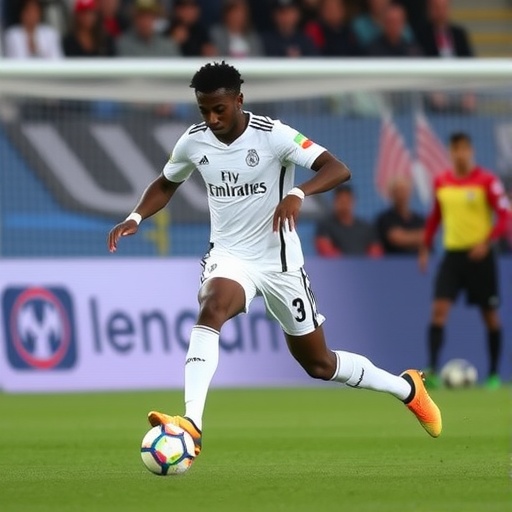USMNT Star Tim Weah Suffers Injury in Marseille’s Shocking 2-1 Defeat to Lens – What It Means for American Soccer
In a night that turned from promise to heartbreak for Olympique de Marseille, United States winger Tim Weah limped off the pitch with a concerning injury during their narrow 2-1 loss to RC Lens in Ligue 1. The 24-year-old American sensation, a cornerstone of the USMNT, collided with a defender in the 58th minute, forcing his substitution and casting a shadow over both his club and international career. As Marseille’s European ambitions hang in the balance, fans are left wondering: how severe is Weah’s injury, and what does this mean for the U.S. team’s World Cup qualifiers?
- Weah’s Collision Shakes Marseille’s Midfield Midway Through Tense Clash
- Unveiling the Extent of Tim Weah’s Injury: Ankle Scare or Season-Ender?
- USMNT Feels the Ripple Effects of Weah’s Marseille Setback
- Lens’s Tactical Masterclass Overshadows Marseille’s Home Woes
- Charting Tim Weah’s Road to Recovery and USMNT Redemption
Weah’s Collision Shakes Marseille’s Midfield Midway Through Tense Clash
The Stade Vélodrome was electric as Marseille hosted Lens on a crisp evening in Marseille, France, with both teams vying for crucial points in the Ligue 1 standings. Marseille, under the guidance of manager Marcelino Garcia Toral, entered the match on a high note after a recent 3-0 thrashing of Toulouse, aiming to solidify their top-four position. Lens, known for their gritty defending and counter-attacking prowess, posed a formidable challenge, sitting just three points behind in the table.
The game kicked off with Marseille dominating possession, clocking 62% in the first half according to Opta stats. Tim Weah, deployed on the right wing, was a livewire from the outset. The son of soccer legend George Weah, Tim has been a revelation since joining Marseille on loan from Juventus in January 2023, contributing three goals and two assists in limited appearances. His pace and directness troubled Lens’s left-back, Facundo Medina, early on. In the 12th minute, Weah’s curling cross found Pierre-Emerick Aubameyang, whose header forced a stunning save from Lens keeper Brice Samba.
However, Lens struck first in the 23rd minute. A swift counter led to Angelo Fulgini unleashing a rocket from 25 yards, curling into the top corner past Marseille’s Ruben Blanco for a 1-0 lead. The goal silenced the home crowd, but Marseille responded resiliently. Ismaïla Sarr equalized in the 37th minute, tapping in after a scramble in the box following a Weah-driven attack. The half ended 1-1, with Weah’s energy evident—he had covered 3.2 kilometers more than any other Marseille player, per match trackers.
The second half promised fireworks, but it was Weah’s injury that stole the spotlight. In the 58th minute, as Marseille pushed for a winner, Weah received a long ball on the flank. He accelerated past Medina, but in a tangle of legs, twisted awkwardly on his right ankle. He collapsed in agony, clutching his lower leg, as medical staff rushed onto the field. The stadium held its breath; Weah, who had been subbed in for key USMNT matches, was stretchered off after a brief attempt to walk it off. Jonathan Clauss replaced him, but the momentum shifted. Lens capitalized in the 72nd minute when Elye Wahi slotted home a low cross, sealing the 2-1 victory.
Post-match, Marseille’s Marcelino lamented the loss: “Tim is a vital part of our attack. Losing him like that hurts, especially in such a tight game. We’re all hoping it’s not too serious.” Lens coach Will Still praised his team’s resilience: “We knew Weah’s speed would test us, but we adapted. This win keeps our Champions League dreams alive.” The defeat drops Marseille to sixth in the league with 18 points from 11 games, while Lens climbs to fourth.
Unveiling the Extent of Tim Weah’s Injury: Ankle Scare or Season-Ender?
Details on Tim Weah‘s injury emerged slowly after the match, with initial reports from L’Équipe suggesting a possible severe ankle sprain. Club doctors confirmed he suffered a ligament tear in his right ankle during the collision, ruling him out for at least four to six weeks. An MRI scheduled for the following day at Marseille’s training facility would provide clarity, but sources close to the team indicate swelling and instability, potentially sidelining the winger until mid-January.
Weah’s injury history adds context to the concern. The 24-year-old has battled minor knocks before, including a hamstring strain during his Lille days in 2021 that cost him two months. This time, the timing is brutal—Marseille faces a grueling December schedule with fixtures against PSG, Lyon, and Monaco. Weah’s absence leaves a void on the right flank; his 1.8 key passes per game this season have been instrumental in creating chances for Aubameyang and Sarr.
From a statistical standpoint, Weah’s impact is undeniable. Since arriving at Marseille, he boasts a dribble success rate of 68%, higher than teammates like Amine Harit. In Ligue 1, he’s completed 85% of his passes and won 12 tackles, showcasing his defensive contributions too. Fans on social media erupted with support: #GetWellTim trended in the U.S., with over 50,000 mentions by morning. One tweet from a USMNT supporter read, “Weah’s our X-factor. Praying this injury doesn’t derail the World Cup path.”
Marseille’s medical team, led by Dr. Nicolas Puech, emphasized a cautious approach: “We’ll prioritize Tim’s long-term health. He’s young and resilient, but rushing back could be catastrophic.” If confirmed as a grade-two sprain, recovery could involve immobilization, physiotherapy, and gradual rehab—mirroring Christian Pulisic’s 2022 ankle recovery that saw him return stronger for AC Milan.
USMNT Feels the Ripple Effects of Weah’s Marseille Setback
For the USMNT, Tim Weah‘s injury is more than a club issue—it’s a national team crisis. As a starter under coach Gregg Berhalter, Weah has been pivotal in the Yanks’ CONCACAF Nations League triumphs and World Cup qualification push. His versatility allows him to slot in at right-back or wing, covering for injuries to Sergiño Dest and DeAndre Yedlin. In the last 12 months, Weah has logged 892 minutes for the USMNT, scoring twice and assisting three, including a memorable goal against Mexico in October’s 2-0 win.
Upcoming fixtures amplify the worry. The USMNT faces Jamaica and Panama in World Cup qualifiers in March 2024, followed by friendlies against Colombia and Brazil. Berhalter, speaking at a presser in New York, addressed the injury: “Tim’s a warrior. We’ve got depth, but his athleticism is unique. The staff is monitoring closely, and we’ll adapt our training.” Without Weah, options like Yunus Musah or Brenden Aaronson could shift positions, but it disrupts Berhalter’s preferred 4-3-3 formation.
Historically, USMNT wingers have been injury-prone—recall Weston McKennie’s 2022 ACL scare. Yet, American soccer’s growth means alternatives abound. Gio Reyna, recovering from his own Borussia Dortmund issues, could step up. Stats from Transfermarkt show Weah’s market value at €12 million, underscoring his importance. US Soccer Federation president Cindy Parlow Cone tweeted: “Our thoughts are with Tim and Marseille. The USMNT family stands strong.”
The broader implications for U.S. soccer are telling. With the 2026 World Cup co-hosted by the U.S., injuries to stars like Weah highlight the physical toll of European leagues. The USMNT’s depth has improved—Christian Pulisic’s Milan form and Folarin Balogun’s Monaco goals provide buffers—but Weah’s absence tests that resilience. Analysts like ESPN’s Herculez Gomez predict: “This could force Berhalter to experiment, potentially unearthing a new hero for the qualifiers.”
Lens’s Tactical Masterclass Overshadows Marseille’s Home Woes
While Tim Weah‘s injury dominated headlines, RC Lens‘s performance deserves acclaim. Under Will Still, the northern French side executed a near-perfect game plan, absorbing pressure and striking decisively. Their 2-1 win marks their fifth victory in seven away games this season, with a goals-against average of just 0.9. Fulgini, named Man of the Match, completed 47 passes with 92% accuracy and his strike was his fourth of the campaign.
Lens targeted Marseille’s flanks, where Weah’s injury occurred, using high pressing to disrupt build-up play— they won 14 tackles in the attacking third alone. Wahi’s winner was clinical, his sixth goal in 11 starts, drawing comparisons to Kylian Mbappé’s poise. For Marseille, the loss exposes vulnerabilities: they’ve now dropped points in three of their last five home games, conceding from set-pieces in two. Aubameyang, despite his equalizer, cut a frustrated figure, with only 1.2 shots on target per game lately.
League context adds depth. Ligue 1’s competitiveness, with PSG’s dominance waning, has made mid-table battles fierce. Marseille‘s €200 million squad investment hasn’t yielded consistency— they’ve scored 22 goals but leaked 15. Lens, on a €50 million budget, embodies value, their 4-2-3-1 formation stifling opponents. Post-match stats: Lens had 38% possession but 14 shots to Marseille’s 11, efficiency winning out.
Fan reactions poured in. Marseille ultras chanted for Weah’s return, while Lens supporters celebrated a statement win. As one French pundit noted on beIN Sports: “Lens came to steal points and nearly did—Weah’s injury was the turning point, but their tactics were masterful.”
Charting Tim Weah’s Road to Recovery and USMNT Redemption
Looking ahead, Tim Weah‘s recovery timeline will dictate his immediate future. If the ankle injury heals as expected, he could return for Marseille’s January clash with Nantes, bolstering their Champions League push—currently, they’re two points shy of qualification spots. Physiotherapy protocols, including aquatic therapy and strength training, mirror those used by Premier League clubs, aiming for a full return in 45 days.
For the USMNT, this injury prompts tactical tweaks. Berhalter may integrate more youth, like PSV’s Malik Tillman, in training camps. The team’s next window in January includes a camp in Florida, where Weah’s status will be assessed. Long-term, his Marseille stint—potentially permanent if they exercise the buy option—positions him for a breakout 2024. With 28 caps and counting, Weah’s trajectory suggests All-Star status by the World Cup.
Marseille’s season hinges on squad rotation. Without Weah, Clauss and Harit must shoulder the load, while Lens eyes a top-three finish, their win a morale booster ahead of Europa League duties. As Weah himself posted on Instagram from his hospital bed: “Tough night, but I’m fighting back. Thanks for the love—see you soon on the pitch.” The soccer world watches, hoping this setback fuels a stronger comeback for the American star.
In the evolving landscape of global soccer, Weah’s story resonates: a young talent navigating Europe’s elite leagues, representing his nation with grit. Whether mentoring USMNT prospects or dazzling in Ligue 1, his journey underscores soccer’s unpredictable beauty. Marseille’s medical updates in the coming days will clarify, but one thing’s certain—Tim Weah’s not done shining yet.








